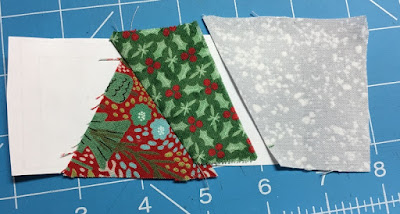 |
| Christmas Elves, Block 3, 8" x 9" |
The center block for this wall hanging was always meant to be the very last block, but a series of unfortunate events interfered with the plan.
Excuses
1. I messed up on my lovely schedule and I had only allowed two weeks between publishing Block 2 and Block 3. Calendars, counting, and dialing telephone numbers always give me trouble, so this was no big surprise.
2. Last week my other self took over, and first thing I knew I was designing and sewing a sleigh. Also, no surprise. My patterns always prefer to design themselves at will.
3. Because of excuses 1 and 2, the companion blocks for the elf carrying packages fell way behind schedule. I made at least three attempts at blocks that didn't work at all, so the last companion block is yet to be designed.
4. Unplanned events like two unexpected doctor visits, a broken ceiling fan, numerous hubby interruptions, and other odds and ends have interfered with my already shortened work time. Why does this always happen when a person is in a hurry?
A Promise
From now on, I will do my best to stay on track and get the Elf with pakages group of patterns, now named Block 4, ready no later than next weekend. I am determined to have the entire pattern completed on schedule on October 14, as planned. Fingers crossed!
The Sleigh
I seriously considered redoing the block from scratch and repositioning the boxes. They seem just a tad off kilter to me, but I didn't know how to work it into on time to get something out on September 2. I've almost convinced myself that it will do, so it's staying as is. It will make me crazy forever, I know, but so be it.
An Option
A couple of years ago, I designed "Ready for Takeoff", a sleigh on a mug rug. As you can see, the two sleighs have some similarities and some differences. The proportions of the two sleighs are quite different. The new sleigh is also red with snowflake trim, but it's longer, lower, and sleeker. It contains a tree rather than Santa's bag because the elf in (the new) Block 5 is stuffing a bag with packages. Two bags in one wall hanging felt like one too many. The original sleigh also fits on a smaller block. You can see the difference in this side by side photo.
If you already have the first pattern and want to use that instead, you definitely can. You will need to enlarge it about 110% and either add to the contents or pile the contents a bit taller to fill the 8" vertical space better.
A Happy Note
It's September!
School is underway and cooler weather will move in.
When I was growing up, September was my favorite month of the year. My mother and I went shopping together. New school clothes were wonderful, but the new school supplies were my favorites. Fresh yellow pencils, unmarked pink erasers, pens, ink, plus lovely notebooks and binders filled with brand new packages of paper. I could never have enough paper! Mom always let me stock up on art supplies, too. I was allowed fresh crayons, colored pencils, water colors, and a sketch pad. Also, by the end of summer, I was really missing the chance to meet new teachers, learn new things, and make new friends.
September is also my birthday month. That made it just about as perfect.
Wishing you a fabulous month!
 |
| School Wall Hanging |




















































